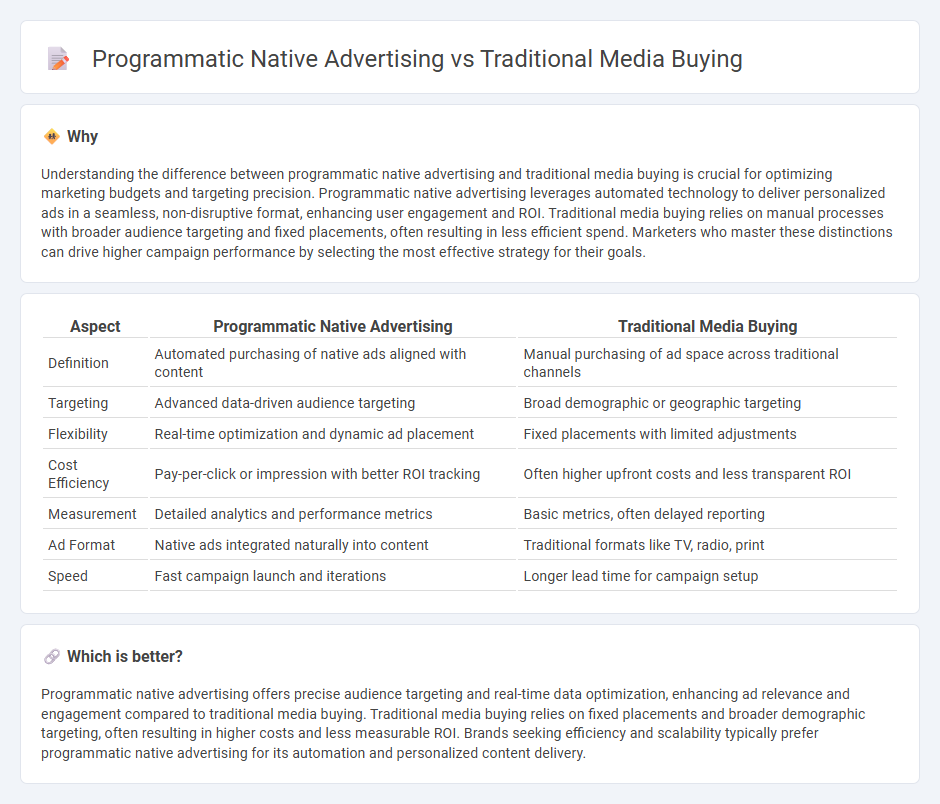
Programmatic native advertising leverages automated technology to deliver personalized ads seamlessly within content, enhancing user engagement and targeting precision compared to traditional media buying's manual, less-targeted approach. Traditional media buying relies on fixed placements and broader audience segments, often resulting in higher costs and lower ROI. Explore how programmatic native advertising can transform your marketing strategy by maximizing efficiency and impact.
Why it is important
Understanding the difference between programmatic native advertising and traditional media buying is crucial for optimizing marketing budgets and targeting precision. Programmatic native advertising leverages automated technology to deliver personalized ads in a seamless, non-disruptive format, enhancing user engagement and ROI. Traditional media buying relies on manual processes with broader audience targeting and fixed placements, often resulting in less efficient spend. Marketers who master these distinctions can drive higher campaign performance by selecting the most effective strategy for their goals.
Comparison Table
| Aspect | Programmatic Native Advertising | Traditional Media Buying |
|---|---|---|
| Definition | Automated purchasing of native ads aligned with content | Manual purchasing of ad space across traditional channels |
| Targeting | Advanced data-driven audience targeting | Broad demographic or geographic targeting |
| Flexibility | Real-time optimization and dynamic ad placement | Fixed placements with limited adjustments |
| Cost Efficiency | Pay-per-click or impression with better ROI tracking | Often higher upfront costs and less transparent ROI |
| Measurement | Detailed analytics and performance metrics | Basic metrics, often delayed reporting |
| Ad Format | Native ads integrated naturally into content | Traditional formats like TV, radio, print |
| Speed | Fast campaign launch and iterations | Longer lead time for campaign setup |
Which is better?
Programmatic native advertising offers precise audience targeting and real-time data optimization, enhancing ad relevance and engagement compared to traditional media buying. Traditional media buying relies on fixed placements and broader demographic targeting, often resulting in higher costs and less measurable ROI. Brands seeking efficiency and scalability typically prefer programmatic native advertising for its automation and personalized content delivery.
Connection
Programmatic native advertising integrates traditional media buying by automating ad placements across digital platforms while maintaining the contextual relevance and native format typical of traditional media. This approach leverages data-driven insights and real-time bidding to optimize targeting efficiency, enhancing the effectiveness of conventional media strategies. Combining programmatic technology with established buying frameworks streamlines campaign management and maximizes return on investment through precise audience segmentation and dynamic content delivery.
Key Terms
Manual Negotiation
Manual negotiation in traditional media buying involves direct communication between advertisers and publishers, allowing for personalized deals and fixed pricing based on audience targeting and inventory availability. In contrast, programmatic native advertising automates the negotiation process through real-time bidding algorithms, optimizing ad placements dynamically to maximize ROI and campaign efficiency. Explore the advantages of each method to determine the best fit for your advertising strategy.
Real-Time Bidding
Traditional media buying relies on fixed schedules and negotiated rates, often lacking flexibility and real-time optimization. Programmatic native advertising leverages Real-Time Bidding (RTB) to dynamically purchase ad space, targeting audiences more precisely and maximizing ROI through automated auctions. Explore how RTB transforms advertising strategies by enhancing efficiency and personalization in native ads.
Contextual Targeting
Traditional media buying relies on manual negotiations and fixed placements, often lacking real-time context adaptation, whereas programmatic native advertising utilizes AI-driven algorithms to dynamically match ads with relevant content based on contextual targeting parameters such as keywords, user behavior, and device type. This approach improves ad relevance and engagement by delivering tailored messages that seamlessly integrate into the user experience across digital platforms. Discover how contextual targeting in programmatic native advertising can elevate your campaigns and maximize ROI.
Source and External Links
Traditional Media Buying: The Ultimate Guide - Colling Media - Traditional media buying involves negotiating ad placements on broadcast channels like TV and radio through media reps, focusing on cost, reach, frequency, and target audience within a budget to support overall marketing strategy.
The 2024 Media Buying Showdown: Programmatic vs. Traditional - It describes traditional media buying as a manual, negotiation-driven process involving multiple stakeholders to purchase ad space on platforms like TV, radio, and print, but with challenges like limited targeting and difficulty measuring ROI.
Digital & Traditional Media Buying Services - Avail Media Group - This explains the integration of traditional media buying across various platforms like TV, radio, and outdoor, emphasizing negotiations for lower rates and combining traditional with digital buying for maximum audience reach and efficiency.
 dowidth.com
dowidth.com